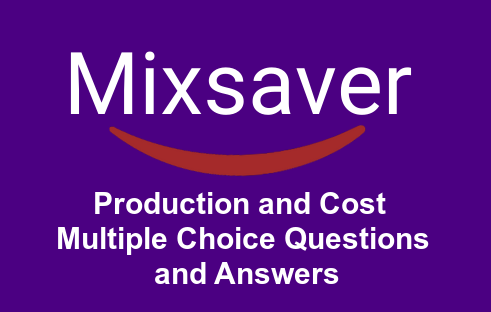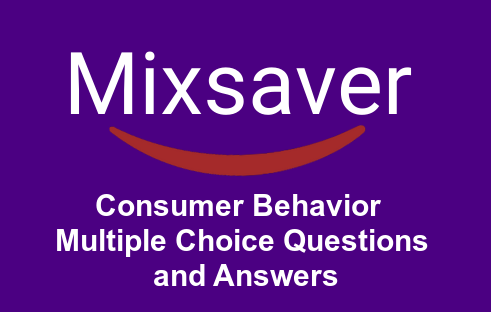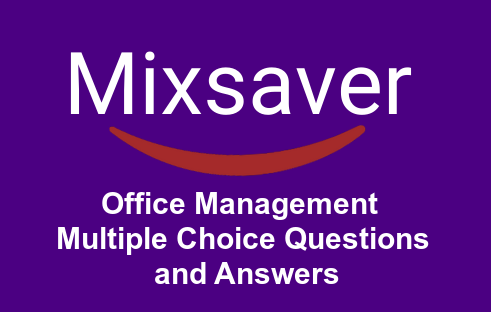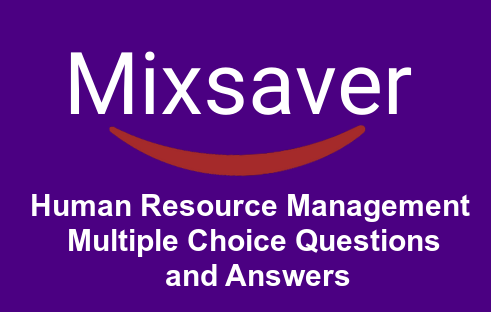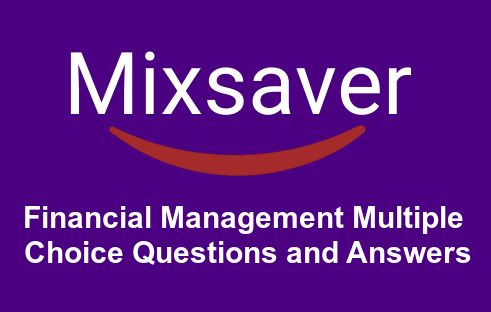1. Cost of quality = Prevention Cost + Appraisal cost + Failure cost
A. True
B. False
Ans: A
2. A useful tool to visualize, clarify, link, identify, and classify possible cause of a problem. This is also called as “fishbone diagram” what is this?
A. Pareto Analysis
B. Cause-and-Effect Diagram
Ans: B
3. It measures the quality of processes used to create a quality product.
It is a system of management activities,
It is a preventive process, It applies for entire life cycle & Deals with Process.
A. Validation
B. Verification
C. Quality Assurance
D. Quality Control
Ans: C
4. Variance from product specifications is called?
A. Report
B. Requirement
C. Defect
Ans: C
5. Verification is
A. Process based
B. Product based
Ans: A
6. White box testing is not called as________.
A. Glass box testing
B. Closed box testing
C. OPen box testing
D. Clear box testing
Ans: B
7. Name the events that will be analyzed, Count the named incidents, Rank the count by frequency using a bar chart & Validate reasonableness of the analysis is called as
A. Pareto Analysis
B. Cause and Effect Diagram
C. SWOT Analysis
D. Pie Charts
Ans: A
8. Retesting of a single program or component after a change has been made?
A. Full Regression Testing
B. Unit Regression
C. Regional Regression
D. Retesting
Ans: B
9. Requirement and Analysis, Design, Development or Coding, Testing and Maintenance is called as Software Development Life Cycle (SDLC)
A. True
B. False
Ans: A
10. The testing which is done by going thro' the code is known as,
A. Unit Testing
B. Blackbox testing
C. White box Testing
D. Regression testing
Ans: C
11. Configuration Management Plan describes the Configuration Management procedures and structures to be used.
A. True
B. False
Ans: A
12.This type of testing method attempts to find incorrect or missing functions, errors in data structures or external database access, interface errors, Performance errors and initialization and Termination errors. It is called as
A. White Box Testing
B. Grey Box Testing
C. Black Box Testing
D. Open Box Testing
Ans: C
13. Phase Definition. It will come under
A. CMM Level 1
B. CMM Level 2
C. None
Ans: B
14. Software testing which is done without planning and Documentation is known as
A. adHoc Testing
B. Unit Testing
C. Regression testing
D. Functional testing.
Ans: A
15. Acceptance testing is known as
A. Beta Testing
B. Greybox testing
C. Test Automation
D. White box testing
Ans: A
16. Retesting the entire application after a change has been made called as?
A. Full Regression Testing
B. Unit Regression
C. Regional Regression
D. Retesting
Ans: A
17. Boundary value analysis belongs to which testing method?
A. Black Box testing
B. White Box testing
Ans: A
18. It measures the quality of a product It is a specific part of the QA procedure, It is a corrective process, It applies for particular product & Deals with the product.
A. Validation
B. Verification
C. Quality Assurance
D. Quality Control
Ans: D
19. What are the Types of Integration Testing?
A. Big Bang Testing
B. Bottom Up Testing
C. Top Down Testing
D. All the above
Ans: D
20. Product Risk affects The quality or performance of the software.
A. True
B. False
Ans: A
21. A metric used to measure the characteristic of documentation and code called as
A. Process metric
B. Product Metric
C. Test metrics
Ans: B
22. Which is non-functional software testing?
A. Unit Testing
B. Block box testing
C. Performance Testing
D. Regression testing
Ans: C
23. The process that deals with the technical and management issues of software development called as?
A. Delivery Process
B. Testing Process
C. Software Process
Ans: C
24. Executing the same test case on a modified build called as
A. Regression Testing
B. Retesting
C. Ad hoc Testing
D. Sanity Testing
Ans: A
25. Which is Black-Box Testing method?
A. equivalence partitioning
B. code coverage
C. fault injection
Ans: A
26. Business Risk affects The Organization developing or Procuring the software.
A. True
B. False
Ans: A
27. Stratification is a Technique used to analyze/divide a universe of data into homogeneous groups(stratA..
A. True
B. False
Ans: A
28. Automation Testing should be done before starting Manual testing. Is the above statement correct?
A. Yes
B. No
Ans: B
29. Earlier a defect is found the cheaper it is to fix it. Is the above statement correct?
A. Yes
B. No
Ans: A
30. Informing to the developer which bug to be fix first is called as
A. Severity
B. Priority
C. Fix ability
D. Traceability
Ans: B
31. Software Testing is a process of evaluating a system by manual or automatic means and verify that it satisfies specified requirements or identity differences between expected and actual results.
A. True
B. False
Ans: A
32. Retesting modules connected to the program or component after a change has been made?
A. Full Regression Testing
B. Unit Regression
C. Regional Regression
D. Retesting.
Ans: C
33. An Important metric is the number of defects found in internal testing compared to the defects found in customer tests, Status of test activities against the plan, Test coverage achieved so far, comes under
A. Process Metric
B. Product Metric
C. Test Metric
Ans: C
34. Alpha testing will be done at,
A. User's site
B. Developers' site
Ans: B
35. SPICE Means
A. Software Process Improvement and Capability Determination
B. Software Process Improvement and Compatibility Determination.
C. Software Process Invention and Compatibility Determination.
D. Software Process Improvement and Control Determination
Ans: A
36. Requirements Specification, Planning, Test case Design, Execution,
Bug Reporting & Maintenance This Life Cycle comes Under
A. SDLC
B. STLC
C. SQLC
D. BLC
Ans: B
37. It provides a set of levels and an assessment model, and presents a set of recommended practices that allow organizations to improve their testing processes.
A. TIM (Testing Improving Model)
B. TMM (Testing Maturity Model)
C. TQM(Total Quality Management)
Ans: A
38. Standards and procedures for managing changes in an evolving software product is called?
A. Confirmation Management
B. Confederation Mangement
C. Configuration Management
D. Compartability Management
Ans: C
39. Path Tested = Number of Path Tested / Total Number of Paths
A. True
B. False
Ans: A
40. This Testing Technique examines the basic program structure and it derives the test data from the program logic; Ensuring that all statements and conditions executed at least once. It is called as
A. Block box Testing
B. White box Testing
C. Grey Box Testing
D. Closed Box Testing
Ans: B
41. This type of test include, how well the user will be able to understand and interact with the system?
A. Usability Testing
B. User Acceptance Testing
C. Alpha Testing
D. Beta Testing.
Ans: A
42. Defects generally fall into the following categories?
A. WRONG
B. MISSING
C. EXTRA
D. All the above
Ans: D
43. What is correct Software Process Cycle?
A. Plan(P)------>Check(C)------>Act(A)----->Do(D)
B. Plan(P)------>Do(D)------>Check(C)----->Act(A)
C. Plan(P)------>Do(D)------>Act(A)----->Check(C)
Ans: B
44. Conducted to validate that the application, database, and network they may be running on can handle projected volumes of users and data effectively. The test is conducted jointly by developers, testers, DBA’s and network associates after the system Testing called as
A. Functional Testing
B. Stress/Load Testing
C. Recovery Testing
D. Integration Testing
Ans: B
45. Maintenance Plan predicts the maintenance requirements of the system, maintenance costs and effort required
A. True
B. False
Ans: A
46. Beta testing will be done by
A. Developer
B. User
C. Tester
Ans: B
47. Validation plan describes the approach ,resources and schedule used for system validation
A. True
B. False
Ans: A
48. Integration, It will come under
A. CMM Level 1
B. CMM Level 3
C. CMM Level 2
D. None
Ans: B
49. Types of quality tools are Problem Identification Tools and Problem Analysis Tools.
A. True
B. False
Ans: A
50. Which Software Development Life cycle model will require to start Testing Activities when starting development activities itself
A. Water falls model
B. Spiral Model
C. V-model
D. Linear model
Ans: C
51. A metric used to measure the characteristic of the methods, Techniques and tools employed in developing, implementing and maintaining the software system called as
A. Process metric
B. Product Metric
C. Test metrics
Ans: A
52. Check Sheet(Checklist. is considered a simple , but powerful statistical tool because it differentiates between two extremes.
A. True
B. False
Ans: A
53. Application should be stable. Clear Design and Flow of the application is needed for Automation testing.
A. False
B. True
Ans: B
54. Quality plan describes the quality procedures and standards that will be used in a project.
A. False
B. True
Ans: B
55. How severely the bug is effecting the application is called as
A. Severity
B. Priority
C. Fix ability
D. Traceability
Ans: A
56. Project Risk affects The Schedule or Resources.
A. True
B. False
Ans: A
57. The name of the testing which is done to make sure the existing features are not affected by new changes
A. Recursive testing
B. Whitebox testing
C. Unit testing
D. Regression testing
Ans: D
58. Management and Measurement, It will come under
A. CMM Level 1
B. CMM Level 3
C. CMM Level 4
D. CMM Level 2
Ans: C
59. AdHoc testing is a part of
A. Unit Testing
B. Regression Tesing
C. Exploratory Testing
D. Performance Testing
Ans: C
60. Cost of Production = Right The First time cost(RTF. + Cost of Quality.
A. True
B. False
Ans: A
61. ------------- means under what test environment(Hardware, software set up. the application will run smoothly
A. Test Bed
B. Checkpoint
C. Code Walk through
D. Checklist
Ans: A
62. TQM represents
A. Tool Quality Management
B. Test Quality Manager
C. Total Quality Management
D. Total Quality Manager
Ans: C
63. Optimization, Defect Prevention, and Quality Control. Its come under the
A. CMM Level 2
B. CMM Level 3
C. CMM Level 4
D. CMM Level5
Ans: D
64. Unit Testing will be done by
A. Testers
B. End Users
C. Customer
D. Developers
Ans: D
65. Beta testing will be done at
A. User place
B. Developers place
Ans: A
66. A Plan to overcome the risk called as
A. Migration Plan
B. Master plan
C. Maintenance plan
D. Mitigation Plan
Ans: D
67. Which of the following is not one of the techniques to find defects
a. Operational Techniques
b. Functional Techniques
c. Dynamic Techniques
d. Static Techniques
Ans: a
68. Quality Assurance methods are usually considered
a. Detective
b. Corrective
c. Preventive
d. Proactive
Ans: C
69. Who has the primary responsibility of setting the quality culture in the organization?
a. Senior Management
b. The Training Department
c. The Quality Department
d. Nobody
Ans: c
70. Verification is
a. Checking that we are building the right system
b. Checking that we are building the system right
c. Performed by an independent test team
d. Making sure that it is what the user really wants
Ans: b
71. A regression test
a. Will always be automated
b. Will help ensure unchanged areas of the software have not been affected
c. Will help ensure changed areas of the software have not been affected
d. Can only be run during user acceptance testing
Ans: b
72. If an expected result is not specified then:
a. we cannot run the test
b. It may be difficult to repeat the test
c. It may be difficult to determine if the test has passed or failed
d. We cannot automate the user inputs
Ans: c
73. Which of the following is not a static testing technique
a. Error guessing
b. Walkthrough
c. Data flow analysis
d. Inspections
Ans: a
74. Which of the following statements about component testing is not true?
a. Component testing should be performed by development
b. Component testing is also known as isolation or module testing
c. Component testing should have completion criteria planned
d. Component testing does not involve regression testing
Ans: d
75. During which test activity could faults be found most cost effectively?
a. Execution
b. Design
c. Planning
d. Check Exit criteria completion
Ans: c
76. The purpose of requirement phase is
a. To freeze requirements
b. To understand user needs
c. To define the scope of testing
d. All of the above
Ans: d
77. Which, in general, is the least required skill of a good tester?
a. Being diplomatic
b. Able to write software
c. Having good attention to detail
d. Able to be relied on
Ans: b
78. The process starting with the terminal modules is called
a. Top-down integration
b. Bottom-up integration
c. None of the above
d. Module integration
Ans: b
79. The inputs for developing a test plan are taken from
a. Project plan
b. Business plan
c. Support plan
d. None of the above
Ans: a
80. Function/Test matrix is a type of
a. Interim Test report
b. Final test report
c. Project status report
d. Management report
Ans: c
81. Defect Management process does not include
a. Defect prevention
b. Deliverable base-lining
c. Management reporting
d. None of the above
Ans: b
82. Software testing accounts to what percent of software development costs?
a. 10-20
b. 40-50
c. 70-80
d. 5-10
Ans: b
83. How much testing is enough
a. This question is impossible to answer
b. The answer depends on the risks for your industry, contract and special requirements
c. The answer depends on the maturity of your developers
d. The answer should be standardized for the software development industry
Ans: b
84. Which of the following is not a characteristic for Testability?
a. Operability
b. Observability
c. Simplicity
d. Robustness
Ans: d
85. Which of these can be successfully tested using Loop Testing methodology?
a. Simple Loops
b. Nested Loops
c. Concatenated Loops
d. All of the above
Ans: d
86. Inspections can find all the following except
a. Variables not defined in the code
b. Spelling and grammar faults in the documents
c. Requirements that have been omitted from the design documents
d. How much of the code has been covered
Ans: d
87. When a new testing tool is purchased, it should be used first by:
a. A small team to establish the best way to use the tool
b. everyone who may eventually have some use for the tool
c. The independent testing team
d. The vendor contractor to write the initial scripts
Ans: a
88. What is the purpose of test completion criteria in a test plan:
A. to know when a specific test has finished its execution
B. to ensure that the test case specification is complete
C. to set the criteria used in generating test inputs
D. to know when test planning is complete
E. to plan when to stop testing
Ans: E
89. Which of the following is NOT a black box technique:
A. Equivalence partitioning
B. State transition testing
C. LCSAJ
D. Syntax testing
E. Boundary value analysis
Ans: C
90. The main focus of acceptance testing is:
A. finding faults in the system
B. ensuring that the system is acceptable to all users
C. testing the system with other systems
D. testing for a business perspective
E. testing by an independent test team
Ans: D
91. Expected results are:
A. only important in system testing
B. only used in component testing
C. never specified in advance
D. most useful when specified in advance
E. derived from the code
Ans: D
92. Which of the following is NOT part of system testing:
A. business process-based testing
B. performance, load and stress testing
C. requirements-based testing
D. usability testing
E. top-down integration testing
Ans: E
93. Which of the following is not part of performance testing:
A. Measuring response time
B. Measuring transaction rates
C. Recovery testing
D. Simulating many users
E. Generating many transactions
Ans: C
94. Which one of the following are non-functional testing methods?
A. System testing
B. Usability testing
C. Performance testing
D. Both b & c
Ans: D
95. During the software development process, at what point can the test process start?
A. When the code is complete.
B. When the design is complete
C. When the software requirements have been approved
D. When the first code module is ready for unit testing
Ans: C
96. Acceptance test cases are based on what?
A. Requirements
B. Design
C. Code
D. Decision table
Ans: A
97. Independent Verification & Validation is
A. Done by the Developer
B. Done by the Test Engineers
C. Done By Management
D. Done by an Entity Outside the Project’s sphere of influence
Ans: D
98. Which of the following is not described in a unit test standard?
A. syntax testing
B. equivalence partitioning
C. stress testing
D. modified condition/decision coverage
Ans: C
99. Which of the following is a form of functional testing?
A. Boundary value analysis
B. Usability testing
C. Performance testing
D. Security testing
Ans: A
100. Test cases are designed during:
A. test recording
B. test planning
C. test configuration
D. test specification
Ans: D

